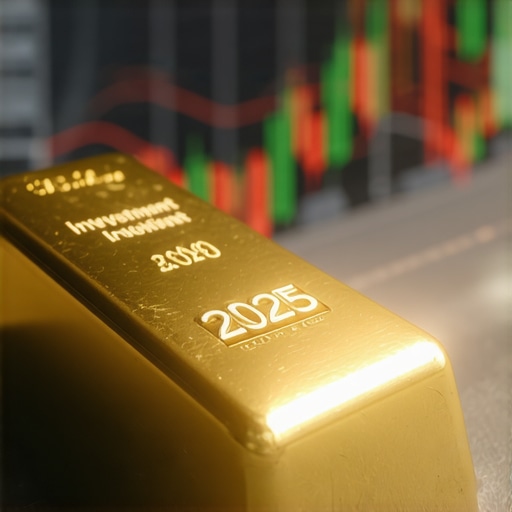Strategic Approaches to Gold Investment Amidst Global Economic Turbulence
In an era marked by mounting geopolitical tensions, inflationary pressures, and unpredictable market volatility, gold remains a timeless sanctuary for preserving wealth. Its intrinsic value and historical resilience during crises position gold as an indispensable component of a sophisticated investment portfolio designed to withstand economic uncertainty. Understanding nuanced gold investment strategies beyond conventional wisdom is critical for investors aiming to optimize returns while mitigating risk in 2025.
Advanced Diversification: Balancing Physical and Paper Gold Assets
Expert investors recognize that a balanced allocation between physical gold—such as bullion bars and coins—and financial instruments like gold ETFs and futures contracts can harness the unique benefits of each. Physical gold offers tangible security against systemic risks and currency debasement, while ETFs provide liquidity and ease of portfolio rebalancing. Strategic integration of these asset classes demands precise timing and market analysis to capitalize on gold’s safe-haven appeal without compromising portfolio agility. For detailed guidance on choosing between physical gold bars and coins, refer to this expert resource.
Inflation Hedging Through Gold: Mechanisms and Market Dynamics
Gold’s role as a hedge against inflation is multifaceted, influenced by real interest rates, currency fluctuations, and central bank policies. Sophisticated investors monitor the interplay between these factors to anticipate gold price movements. For instance, when real interest rates remain negative, gold’s opportunity cost diminishes, enhancing its attractiveness as a store of value. Additionally, central bank gold acquisitions can signal confidence in gold’s stability, further influencing demand and pricing. The analytical framework provided in this authoritative guide deepens understanding of these market drivers.
How can investors optimize gold trading techniques to navigate price volatility during economic downturns?
Navigating gold price volatility requires mastery of technical analysis, timing market entry and exit points, and understanding macroeconomic indicators that influence gold demand. Investors can leverage futures trading to hedge positions, employing stop-loss orders to limit downside risks while exploiting upward price momentum. Continuous monitoring of global economic indicators, such as inflation data and geopolitical developments, informs adaptive trading strategies. Resources like mastering gold trading techniques provide actionable insights for both novice and experienced investors seeking to enhance portfolio resilience.
Integrating Gold into a Diversified Portfolio for Long-Term Stability
Incorporating gold alongside equities, bonds, and alternative assets fortifies portfolios against systemic shocks. Gold’s low correlation with traditional asset classes reduces overall portfolio volatility and enhances risk-adjusted returns. Strategic allocation percentages depend on individual risk tolerance and investment horizons, but typically range from 5% to 15% of total assets. For an expert perspective on balancing gold with stocks and other holdings, explore this comprehensive analysis.
Call to Action: Elevate Your Gold Investment Acumen
Investors committed to navigating the complexities of gold markets amid economic uncertainty are encouraged to deepen their expertise through advanced resources and community discourse. Engage with specialized content and contribute your insights on platforms dedicated to gold investment strategies to refine your approach and stay ahead of emerging trends.
For further authoritative insights, the World Gold Council’s research hub offers in-depth market analysis and data essential for informed decision-making.
Leveraging Gold Derivatives for Tactical Portfolio Enhancement
Beyond traditional physical gold holdings and ETFs, derivatives such as gold futures and options offer sophisticated investors powerful tools to amplify portfolio performance and manage risk dynamically. Futures contracts allow investors to lock in prices or speculate on gold’s direction without immediate capital outlay, providing leverage to capitalize on short-term market movements. Options, conversely, grant the right but not the obligation to buy or sell gold at predetermined prices, offering strategic flexibility during volatile periods.
However, these instruments require a deep understanding of margin requirements, contract specifications, and timing nuances to avoid amplified losses. Integrating derivatives into a gold investment strategy demands rigorous risk management protocols and continuous market vigilance. For a comprehensive introduction, consult this beginner-friendly guide on gold futures trading.
Decoding Global Gold Demand Trends: Implications for Investors
Gold demand trends are increasingly shaped by complex interplays among jewelry consumption, technology industry usage, central bank policies, and investment demand. Notably, emerging markets continue to fuel jewelry and investment demand, while technological applications in electronics and green energy sectors add a nuanced layer of industrial gold consumption. Central banks’ strategic gold purchases further underpin price support and signal macroeconomic confidence.
Investors attuned to these evolving dynamics can better anticipate price shifts and adjust portfolios proactively. Emerging research highlights how geopolitical shifts and currency volatility drive central bank behaviors, which in turn influence gold’s strategic positioning globally. For an exhaustive analysis, visit the World Gold Council’s detailed report on understanding gold demand trends.
How do geopolitical developments reshape gold investment strategies in 2025 and beyond?
Geopolitical events have historically triggered surges in gold’s safe-haven appeal. In 2025, heightened tensions in trade policies, regional conflicts, and shifts in monetary alliances necessitate agile investment strategies. Investors must evaluate the geopolitical landscape continuously, recognizing that gold often responds swiftly to uncertainty, offering portfolio insulation when traditional markets falter.
Strategically, this could mean increasing physical gold allocations during periods of heightened risk or utilizing gold derivatives to hedge against anticipated volatility. Diversification across different forms of gold assets further mitigates location-specific risks. Staying informed through trusted analytical sources and market commentary is essential for timely decision-making.
Utilizing Technological Innovations for Secure Gold Investment Management
Advancements in blockchain and digital ledger technologies are beginning to transform gold investment, enhancing transparency and security. Tokenized gold assets, for example, allow investors to hold fractional ownership of physical gold stored securely in vaults, combining liquidity with tangible asset backing. This approach mitigates traditional storage and insurance challenges while maintaining exposure to gold’s intrinsic value.
While still emerging, these technological solutions represent an important frontier for investors seeking to modernize gold portfolios without sacrificing security. Comprehensive understanding of the regulatory landscape and platform credibility is crucial before adopting these innovations. Explore more about secure purchasing and storage solutions in our article on physical gold storage solutions.
Call to Action: Share Your Insights and Elevate Collective Expertise
We invite seasoned investors and newcomers alike to share their experiences and strategies for optimizing gold investments in today’s complex environment. Your insights can enrich community knowledge and support collective resilience in navigating the evolving gold market. Join the conversation, share this article with your network, and explore our extensive resources to deepen your understanding of gold investment strategies.
For further authoritative insights, refer to the World Gold Council’s research hub for comprehensive market analysis and data essential for strategic investment decisions.
Algorithmic Trading and AI: Transforming Gold Market Navigation for Expert Investors
In the increasingly complex gold investment landscape of 2025, traditional trading methods are being augmented, and often surpassed, by sophisticated algorithmic and artificial intelligence (AI) driven strategies. These cutting-edge technologies empower investors to process vast datasets—from macroeconomic indicators and geopolitical news to real-time market microstructure—to identify subtle patterns and execute trades with unparalleled speed and precision.
Algorithmic trading systems, programmed with advanced quantitative models, can capitalize on short-term gold price inefficiencies or hedge against sudden market shocks. Meanwhile, AI-powered platforms utilize machine learning techniques to adapt dynamically to changing market conditions, improving predictive accuracy over time. This fusion of technology facilitates a proactive approach to gold investment, allowing for nuanced risk management and enhanced portfolio optimization.
What role do machine learning algorithms play in forecasting gold price movements amid volatile global markets?
Machine learning algorithms leverage historical price data alongside multifactor economic variables to discern complex, non-linear relationships influencing gold prices. Models such as recurrent neural networks (RNNs) and long short-term memory networks (LSTMs) excel at capturing temporal dependencies and volatility clustering, which traditional econometric models might overlook. By continuously retraining on new data, these AI systems improve their forecasting robustness, enabling investors to anticipate price spikes or downturns with greater confidence.
For instance, a 2023 study published in the Journal of Commodity Markets demonstrated the superior performance of LSTM networks over conventional ARIMA models in predicting gold price volatility, especially during periods of heightened geopolitical tension and inflationary uncertainty.
Incorporating these insights into trading algorithms allows for the calibration of entry and exit points that respond swiftly to market signals, optimizing returns while mitigating downside risks.
Quantitative Risk Modeling: Enhancing Gold Portfolio Resilience through Stress Testing and Scenario Analysis
Advanced investors increasingly rely on quantitative risk models to evaluate the resilience of gold holdings under diverse economic scenarios. Techniques such as Monte Carlo simulations and Value-at-Risk (VaR) assessments provide probabilistic insights into potential portfolio drawdowns during black swan events or systemic crises.
By integrating macroeconomic stress tests—simulating scenarios like rapid interest rate hikes, currency devaluations, or geopolitical escalations—investors can identify vulnerabilities and adjust gold allocations accordingly. This approach moves beyond static asset allocation models to a dynamic framework that anticipates and prepares for extreme market environments.
Moreover, coupling these models with behavioral finance analytics helps decipher investor sentiment trends that often precipitate sharp gold price movements, thus refining timing strategies for asset rebalancing.
Environmental, Social, and Governance (ESG) Criteria in Gold Investment: Navigating Ethical and Sustainable Choices
As ESG considerations gain prominence across financial markets, discerning investors are scrutinizing gold sources and mining practices to align portfolios with ethical standards. Responsible gold investment entails evaluating supply chain transparency, labor practices, and environmental impact.
Sustainable gold funds and certified conflict-free gold products are increasingly available, offering exposure to the metal without compromising on social responsibility. Investors integrating ESG metrics not only contribute to positive global outcomes but may also benefit from the growing demand premium associated with ethically sourced gold.
Understanding the complexities of ESG ratings and their implications for gold investment requires specialized knowledge, as standards vary significantly across jurisdictions and certification bodies.
How can investors effectively incorporate ESG factors into gold portfolio construction without sacrificing performance?
Balancing ESG commitments with portfolio performance necessitates a nuanced approach. Investors should leverage third-party ESG rating agencies specializing in precious metals, such as the Responsible Jewellery Council, to assess gold suppliers. Combining these qualitative assessments with quantitative portfolio analytics ensures that ESG integration does not compromise returns.
Furthermore, actively engaging with fund managers and mining companies on ESG issues can influence industry practices and enhance long-term investment sustainability. Access to detailed ESG data and ongoing transparency are critical for informed decision-making.
Call to Action: Embrace Technological and Ethical Frontiers to Master Gold Investing
The confluence of algorithmic innovation, advanced risk modeling, and ESG integration represents the future frontier of gold investment expertise. Investors ready to transcend traditional paradigms should seek continuous education on AI-driven analytics, quantitative risk frameworks, and sustainable sourcing practices.
Delve deeper into these transformative strategies by exploring specialized research at the World Gold Council Research Hub and engaging with thought leadership in quantitative finance and sustainable investing communities.
Quantum Computing: A Paradigm Shift in Gold Market Forecasting
As quantum computing edges closer to commercial viability, its potential to revolutionize financial modeling, particularly in commodities like gold, is becoming increasingly apparent. Quantum algorithms can process combinatorial complexities and high-dimensional data sets beyond classical capabilities, offering unprecedented precision in forecasting gold price trajectories under multifactor economic and geopolitical influences. Investors and hedge funds exploring quantum-enhanced portfolio optimization models stand to gain a competitive edge by identifying arbitrage opportunities and stress-testing asset correlations at speeds unattainable with conventional systems.
How can quantum computing materially enhance predictive accuracy and risk management in gold investment portfolios?
Quantum annealing and gate-based quantum computing facilitate the solving of optimization problems intrinsic to portfolio construction, such as minimizing risk while maximizing returns in gold holdings. By simulating numerous market scenarios simultaneously, quantum processors can uncover non-intuitive correlations and tail risks that classical Monte Carlo simulations may miss. This capability is particularly valuable in modeling gold’s behavior in reaction to abrupt geopolitical shocks or monetary policy shifts.
Recent experimental research by Nature Quantum Information illustrates quantum algorithms outperforming traditional risk models in complex asset allocation tasks, signaling a forthcoming paradigm shift in precious metals investment analytics.
Geo-Economic Analytics: Leveraging Satellite and Big Data for Real-Time Gold Demand Insights
Cutting-edge geo-economic analytics utilize satellite imagery and large-scale data aggregation to monitor gold-related economic activities globally. For example, tracking night-time illumination intensity in mining regions offers proxy indicators for production volumes, while analyzing shipping and customs data reveals real-time supply chain fluctuations. Integrating these unconventional data streams with AI-driven analytics provides investors with near-instantaneous insights into demand-supply imbalances, enabling tactical position adjustments before traditional reports become available.
This data-driven approach empowers investors to anticipate central bank purchase patterns, jewelry market trends, and industrial consumption shifts with heightened accuracy, refining timing and sizing of gold allocations in dynamic market environments.
Dynamic Hedging Strategies: Synthesizing Machine Learning with Behavioral Finance Models
Advancing beyond static hedging frameworks, the integration of machine learning algorithms with behavioral finance enables dynamic hedging strategies tailored to market sentiment and investor psychology. These hybrid models analyze social media sentiment, news sentiment scores, and search trend analytics alongside price and volume data to forecast short-term gold price reactions to emerging narratives.
Consequently, portfolio managers can implement algorithmic triggers that adjust gold exposure proactively, mitigating downside risk during panic-induced sell-offs or capitalizing on momentum during bullish sentiment waves.
Call to Action: Engage with the Frontier of Gold Investment Innovation
For investors committed to mastering the complexities of gold markets in the era of quantum computing, big data, and behavioral analytics, continuous engagement with emerging research and technology platforms is imperative. Explore advanced whitepapers, participate in specialized forums, and collaborate with quantitative finance experts to harness these transformative tools effectively.
Delve deeper into these avant-garde methodologies by visiting the World Gold Council Research Hub and subscribing to journals like Nature Quantum Information to stay abreast of breakthroughs shaping the future of gold investment.

Expert Insights & Advanced Considerations
Algorithmic and AI-Driven Trading Are Redefining Gold Market Strategies
Modern gold investors increasingly harness algorithmic trading systems and machine learning models to analyze complex datasets and execute trades with precision. These technologies enable nuanced forecasting of price volatility and improved timing, surpassing traditional technical analysis methods. Embracing such tools can significantly enhance portfolio responsiveness amid 2025’s economic uncertainties. For a deeper dive, explore mastering gold trading techniques tailored for today’s dynamic environment.
Integrating ESG Criteria Elevates Gold Investment to Ethical and Sustainable Dimensions
Incorporating environmental, social, and governance standards into gold investment decisions is no longer optional but a strategic imperative. Selecting responsibly sourced gold and engaging with certified funds not only aligns portfolios with evolving investor values but may also capture growing demand premiums. Understanding the complexities of ESG ratings and supply chain transparency is essential for maintaining both ethical integrity and investment performance.
Quantum Computing and Geo-Economic Analytics Unlock New Frontiers of Predictive Accuracy
The emerging application of quantum computing promises breakthroughs in optimizing gold portfolio risk-return profiles through enhanced scenario modeling. Complemented by geo-economic analytics leveraging satellite and big data, investors can gain near real-time insights into production, demand, and central bank behavior. Staying abreast of these innovations positions investors at the forefront of strategic gold market navigation.
Dynamic Hedging Combining Machine Learning and Behavioral Finance Enhances Risk Management
Advanced hedging strategies that synthesize AI-driven sentiment analysis with behavioral finance models provide a sophisticated approach to managing gold exposure. By anticipating market psychology and sentiment-driven price swings, investors can adjust allocations proactively, mitigating downside risk and capitalizing on momentum shifts in volatile markets.
Curated Expert Resources
- World Gold Council Research Hub: The definitive source for comprehensive gold market data, trend analyses, and research reports essential for informed decision-making. Explore their research hub.
- Mastering Gold Trading Techniques: An expert guide detailing effective strategies for navigating gold price volatility and optimizing trade execution in 2025. Read more.
- Physical Gold Investment: Choosing Between Bars and Coins: A nuanced resource on selecting the right physical gold assets to balance security and liquidity. Learn more.
- Gold as a Hedge Against Inflation – Essential Facts: Detailed analysis of gold’s inflation-hedging mechanisms and market drivers vital for strategic allocation. Discover insights.
- Physical Gold Storage Solutions – Secure Your Investment Today: Practical guidance on safeguarding physical gold investments with modern storage and security techniques. Find out more.
Final Expert Perspective
The landscape of gold investment in 2025 demands a synthesis of technological innovation, ethical stewardship, and advanced risk management. From the precision of AI and quantum computing-enhanced forecasting to the imperative of ESG integration and dynamic hedging models, expert investors must navigate a multifaceted arena to fully leverage gold’s unique portfolio benefits. Cultivating a well-rounded, informed approach—grounded in authoritative resources and continuous learning—ensures resilience and opportunity capture amid global economic volatility. Engage deeply with these evolving strategies, share your professional insights, and continue exploring the rich resources available to master the art and science of gold investment.











This post provides an excellent overview of the sophisticated approaches needed to navigate gold investment during uncertain economic times. I particularly agree with the emphasis on diversifying between physical gold and paper assets, as I’ve seen firsthand how balancing these can ease liquidity concerns while maintaining a tangible security buffer. In my experience, timing entry and exit points through technical analysis has significantly mitigated risks during volatile periods, especially when using futures with well-planned stop-loss orders.
One thing I wonder about is the integration of blockchain technology and tokenized gold assets. How widespread do you see this becoming, and what are the main hurdles investors face in adopting these modern solutions? It seems like a promising avenue for enhancing liquidity and transparency, especially with the growing importance of ESG criteria. I’m curious how others are approaching technological innovations while maintaining rigorous risk management. Has anyone experimented with or seen successful implementations of tokenized gold in their portfolios? I’d love to hear real-world insights or suggestions on how to leverage these advancements effectively.